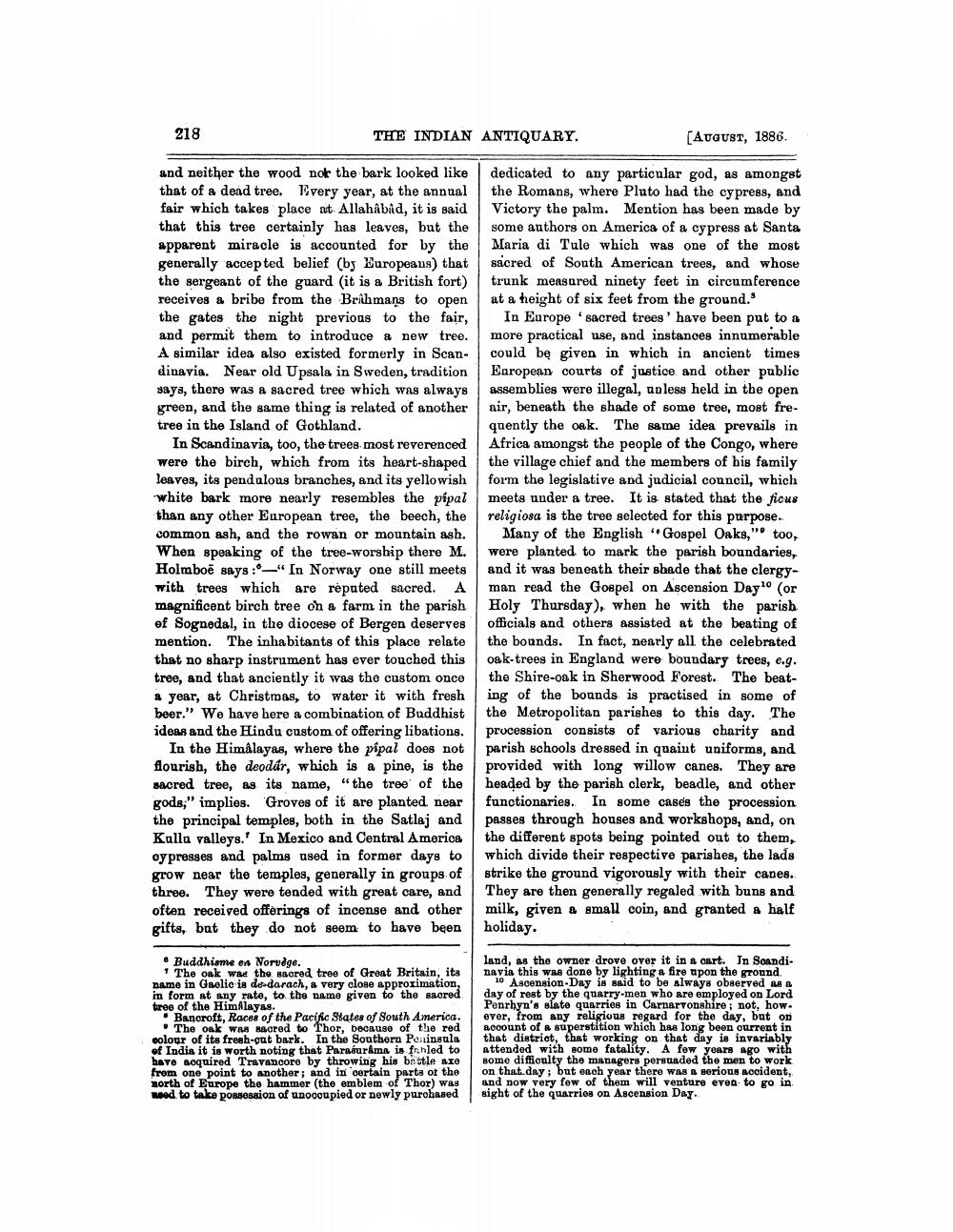________________
218
THE INDIAN ANTIQUARY.
[AUGUST, 1886.
and neither the wood nok the bark looked like that of a dead tree. Every year, at the annual fair which takes place at Allahabad, it is said that this tree certainly has leaves, but the apparent miracle is accounted for by the generally accepted belief (by Europeans) that the sergeant of the guard (it is a British fort) receives a bribe from the Brahmans to open the gates the night previous to the fair, and permit them to introduce a new tree. A similar idea also existed formerly in Scandinavia. Near old Upsala in Sweden, tradition says, there was a sacred tree which was always green, and the same thing is related of another tree in the Island of Gothland.
In Scandinavia, too, the trees most reverenced were the birch, which from its heart-shaped leaves, its pendulous branches, and its yellowish white bark more nearly resembles the pipal than any other European tree, the beech, the common ash, and the rowan or mountain ash. When speaking of the tree-worship there M. Holmboë says:_" In Norway one still meets with trees which are reputed sacred. A magnificent birch tree on a farm in the parish of Sognedal, in the diocese of Bergen deserves mention. The inhabitants of this place relate that no sharp instrument has ever touched this tree, and that anciently it was the custom once a year, at Christmas, to water it with fresh beer." We have here a combination of Buddhist ideas and the Hindu custom of offering libations.
In the Himalayas, where the pipal does not flourish, the deodór, which is a pine, is the sacred tree, as its name, "the tree of the gods;" implies. Groves of it are planted near the principal temples, both in the Satlaj and Kulla valleys.' In Mexico and Central America oy presses and palms ased in former days to grow near the temples, generally in groups of three. They were tended with great care, and often received offerings of incense and other gifts, but they do not seem to have been
dedicated to any particular god, as amongst the Romans, where Pluto had the cypress, and Victory the palm. Mention has been made by some authors on America of a cypress at Santa Maria di Tule which was one of the most sacred of South American trees, and whose trunk measured ninety feet in circumference at a height of six feet from the ground.
In Europe sacred trees' have been put to a more practical use, and instanoes innumerable could be given in which in ancient times Earopean courts of justice and other public assemblies were illegal, apless held in the open air, beneath the shade of some tree, most frequently the oak. The same idea prevails in Africa amongst the people of the Congo, where the village chief and the members of his family form the legislative and judicial council, which meets under a tree. It is stated that the ficus religiosa is the tree selected for this purpose.
Many of the English "Gospel Oaks," too, were planted to mark the parish boundaries, and it was beneath their shade that the clergyman read the Gospel on Ascension Day' (or Holy Thursday), when he with the parish officials and others assisted at the beating of the bounds. In fact, nearly all the celebrated oak-trees in England were boundary trees, e.g. the Shire-oak in Sherwood Forest. The beating of the bounds is practised in some of the Metropolitan parishes to this day. The procession consists of various charity and parish schools dressed in quaint uniforms, and provided with long willow canes. They are headed by the parish clerk, beadle, and other functionaries. In some cases the procession passes through houses and workshops, and, on the different spots being pointed out to them, which divide their respective parishes, the lads strike the ground vigorously with their canes. They are then generally regaled with buns and milk, given a small coin, and granted a half holiday.
• Buddhisme en Norvège.
+ The oak was the sacred tree of Great Britain, its name in Gaelio is de-darach, a very close approximation, in form at any rate, to the name given to the sacred tree of the Himalayas.
• Bancroft, Races of the Pacific States of South America.
• The oak was sacred to Thor, because of the red colour of its fresh-gut bark. In the Southern Peninsula of India it is worth noting that Parasur ma is frhled to have acquired Travancore by throwing his bestle are from one point to another; and in certain parts of the north of Europe the hammer (the emblem of Thor) was wed to take possession of Docoupied or newly purchased
land, as the owner drove over it in a cart. Jn Scandinavia this was done by lighting a fire upon the ground
10 Ascension Day is said to be always observed as & day of rest by the quarry-men who are employed on Lord Penrhyn's slate quarries in Carnarvonshire; not, how. ever, from any religious regard for the day, but on uooount of a superstition which has long been current in that district, that working on that day is invariably attended with some fatality. A few years ago with some difficulty the managers persuaded the men to work on that day; but each year there was a serious accident, and now very few of them will venture even to go in sight of the quarries on Ascension Day.




